spark plugs replace Hyundai Coupe 2002 Owner's Manual
[x] Cancel search | Manufacturer: HYUNDAI, Model Year: 2002, Model line: Coupe, Model: Hyundai Coupe 2002Pages: 140, PDF Size: 1.45 MB
Page 89 of 140
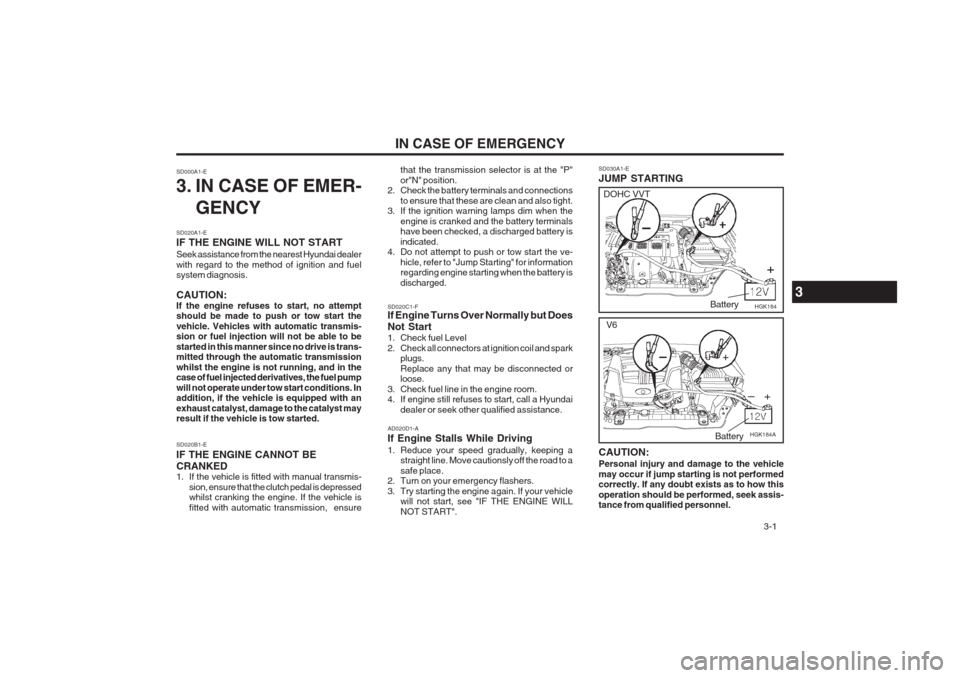
3-1
IN CASE OF EMERGENCY
that the transmission selector is at the "P" or"N" position.
2. Check the battery terminals and connections
to ensure that these are clean and also tight.
3. If the ignition warning lamps dim when the
engine is cranked and the battery terminals have been checked, a discharged battery is indicated.
4. Do not attempt to push or tow start the ve-
hicle, refer to "Jump Starting" for information regarding engine starting when the battery is discharged.
SD000A1-E
3. IN CASE OF EMER-
GENCY
SD020A1-E IF THE ENGINE WILL NOT START Seek assistance from the nearest Hyundai dealer with regard to the method of ignition and fuel system diagnosis. CAUTION: If the engine refuses to start, no attempt should be made to push or tow start the vehicle. Vehicles with automatic transmis- sion or fuel injection will not be able to be started in this manner since no drive is trans- mitted through the automatic transmission whilst the engine is not running, and in the case of fuel injected derivatives, the fuel pump will not operate under tow start conditions. In addition, if the vehicle is equipped with an exhaust catalyst, damage to the catalyst may result if the vehicle is tow started. SD020B1-E IF THE ENGINE CANNOT BECRANKED
1. If the vehicle is fitted with manual transmis- sion, ensure that the clutch pedal is depressedwhilst cranking the engine. If the vehicle is fitted with automatic transmission, ensure SD020C1-F If Engine Turns Over Normally but Does Not Start
1. Check fuel Level
2. Check all connectors at ignition coil and spark
plugs.Replace any that may be disconnected or loose.
3. Check fuel line in the engine room.
4. If engine still refuses to start, call a Hyundai dealer or seek other qualified assistance.
AD020D1-A If Engine Stalls While Driving
1. Reduce your speed gradually, keeping a straight line. Move cautionsly off the road to a safe place.
2. Turn on your emergency flashers.
3. Try starting the engine again. If your vehicle will not start, see "IF THE ENGINE WILLNOT START". SD030A1-E JUMP STARTING
3
HGK184
Battery
DOHC VVT
HGK184A
V6
Battery
CAUTION: Personal injury and damage to the vehicle may occur if jump starting is not performed correctly. If any doubt exists as to how this operation should be performed, seek assis- tance from qualified personnel.
Page 100 of 140
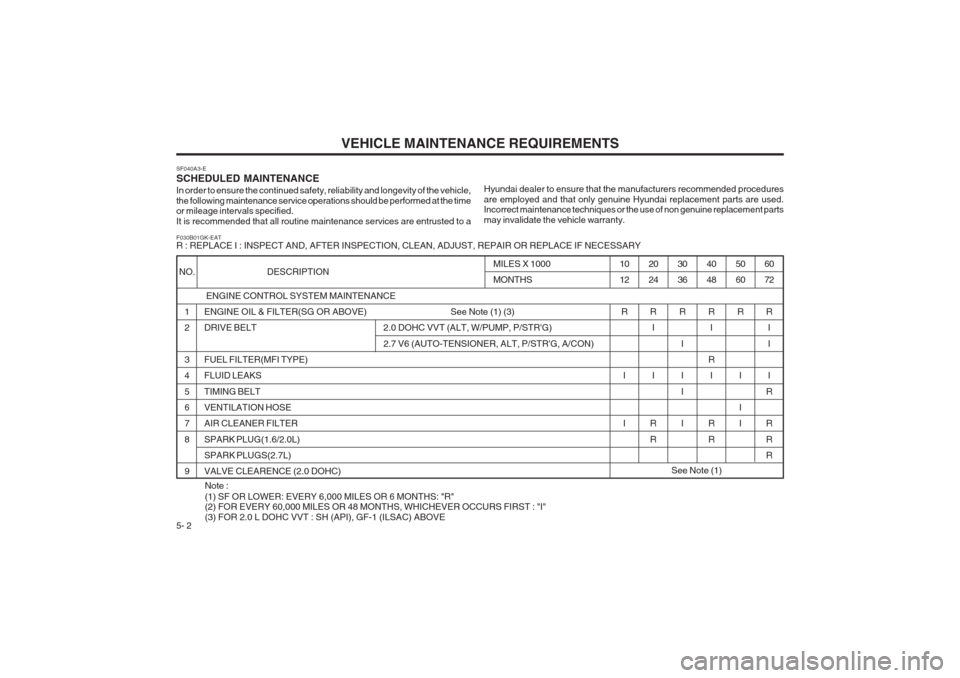
VEHICLE MAINTENANCE REQUIREMENTS
5- 2
SF040A3-E SCHEDULED MAINTENANCE In order to ensure the continued safety, reliability and longevity of the vehicle, the following maintenance service operations should be performed at the time or mileage intervals specified. It is recommended that all routine maintenance services are entrusted to a
Hyundai dealer to ensure that the manufacturers recommended proceduresare employed and that only genuine Hyundai replacement parts are used. Incorrect maintenance techniques or the use of non genuine replacement parts may invalidate the vehicle warranty.
F030B01GK-EAT R : REPLACE I : INSPECT AND, AFTER INSPECTION, CLEAN, ADJUST, REPAIR OR REPLACE IF NECESSARY
ENGINE CONTROL SYSTEM MAINTENANCE
ENGINE OIL & FILTER(SG OR ABOVE) See Note (1) (3)
DRIVE BELT 2.0 DOHC VVT (ALT, W/PUMP, P/STR'G) 2.7 V6 (AUTO-TENSIONER, ALT, P/STR'G, A/CON)
FUEL FILTER(MFI TYPE)FLUID LEAKS TIMING BELT VENTILATION HOSEAIR CLEANER FILTER SPARK PLUG(1.6/2.0L) SPARK PLUGS(2.7L)VALVE CLEARENCE (2.0 DOHC)
NO. DESCRIPTION60 72
R I I I
RR R R
5060
R
I I I
4048
R I
R I
R R
30 36
R I I I I
20 24
R I I
R R
10 12
R
I I
MILES X 1000 MONTHS
Note : (1) SF OR LOWER: EVERY 6,000 MILES OR 6 MONTHS: "R" (2) FOR EVERY 60,000 MILES OR 48 MONTHS, WHICHEVER OCCURS FIRST : "I" (3) FOR 2.0 L DOHC VVT : SH (API), GF-1 (ILSAC) ABOVE
1 2 3 4 5 67 8 9
See Note (1)
Page 102 of 140
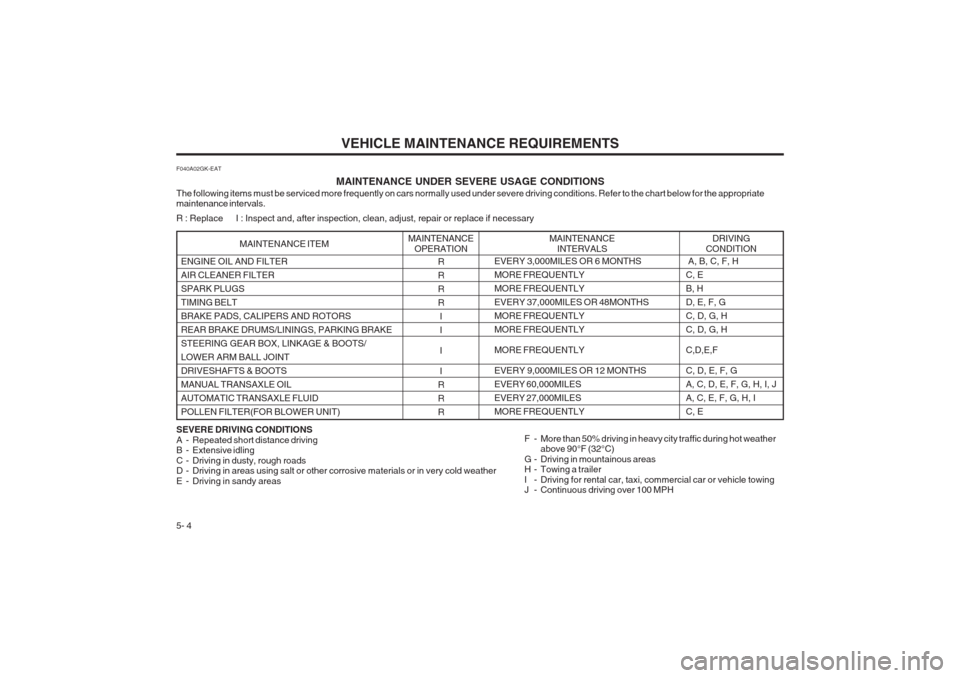
VEHICLE MAINTENANCE REQUIREMENTS
5- 4 MAINTENANCE UNDER SEVERE USAGE CONDITIONS
The following items must be serviced more frequently on cars normally used under severe driving conditions. Refer to the chart below for the appropriate maintenance intervals. R : Replace I : Inspect and, after inspection, clean, adjust, repair or replace if necessary
F040A02GK-EAT
DRIVING
CONDITION
R RRR
II II
R RR
MAINTENANCE ITEM MAINTENANCE
OPERATION MAINTENANCE
INTERVALS
ENGINE OIL AND FILTER AIR CLEANER FILTERSPARK PLUGSTIMING BELTBRAKE PADS, CALIPERS AND ROTORSREAR BRAKE DRUMS/LININGS, PARKING BRAKESTEERING GEAR BOX, LINKAGE & BOOTS/LOWER ARM BALL JOINTDRIVESHAFTS & BOOTSMANUAL TRANSAXLE OILAUTOMATIC TRANSAXLE FLUIDPOLLEN FILTER(FOR BLOWER UNIT) EVERY 3,000MILES OR 6 MONTHSMORE FREQUENTLYMORE FREQUENTLYEVERY 37,000MILES OR 48MONTHSMORE FREQUENTLYMORE FREQUENTLY MORE FREQUENTLYEVERY 9,000MILES OR 12 MONTHS EVERY 60,000MILESEVERY 27,000MILESMORE FREQUENTLY
A, B, C, F, HC, EB, HD, E, F, GC, D, G, HC, D, G, H C,D,E,FC, D, E, F, G A, C, D, E, F, G, H, I, JA, C, E, F, G, H, IC, E
SEVERE DRIVING CONDITIONS
A - Repeated short distance driving
B - Extensive idling
C - Driving in dusty, rough roads
D - Driving in areas using salt or other corrosive materials or in very cold weather
E - Driving in sandy areas F - More than 50% driving in heavy city traffic during hot weather
above 90°F (32°C)
G - Driving in mountainous areas
H - Towing a trailer
I - Driving for rental car, taxi, commercial car or vehicle towing
J - Continuous driving over 100 MPH
Page 103 of 140
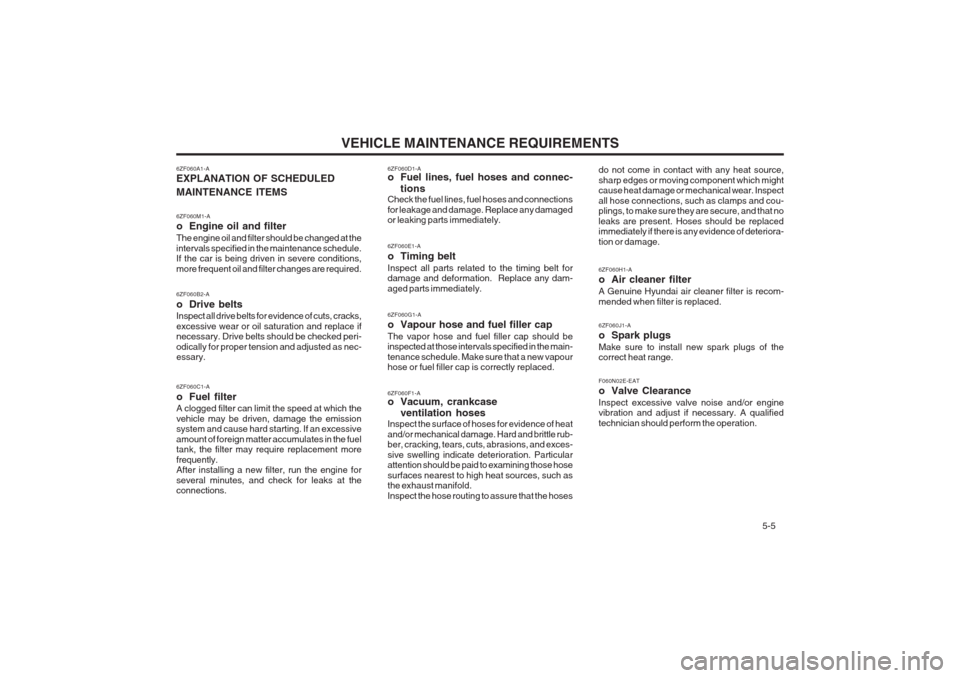
VEHICLE MAINTENANCE REQUIREMENTS 5-5
6ZF060D1-A
o Fuel lines, fuel hoses and connec-
tions
Check the fuel lines, fuel hoses and connections for leakage and damage. Replace any damaged or leaking parts immediately. 6ZF060E1-A o Timing beltInspect all parts related to the timing belt for damage and deformation. Replace any dam- aged parts immediately. 6ZF060G1-A
o Vapour hose and fuel filler cap The vapor hose and fuel filler cap should be inspected at those intervals specified in the main- tenance schedule. Make sure that a new vapour hose or fuel filler cap is correctly replaced. 6ZF060F1-A
o Vacuum, crankcase
ventilation hoses
Inspect the surface of hoses for evidence of heat and/or mechanical damage. Hard and brittle rub- ber, cracking, tears, cuts, abrasions, and exces- sive swelling indicate deterioration. Particular attention should be paid to examining those hose surfaces nearest to high heat sources, such as the exhaust manifold. Inspect the hose routing to assure that the hoses do not come in contact with any heat source,sharp edges or moving component which might cause heat damage or mechanical wear. Inspect all hose connections, such as clamps and cou- plings, to make sure they are secure, and that no leaks are present. Hoses should be replaced immediately if there is any evidence of deteriora- tion or damage. 6ZF060H1-A
o Air cleaner filter A Genuine Hyundai air cleaner filter is recom- mended when filter is replaced. 6ZF060J1-A
o Spark plugs Make sure to install new spark plugs of the correct heat range.
6ZF060A1-A EXPLANATION OF SCHEDULED MAINTENANCE ITEMS 6ZF060M1-A
o Engine oil and filter The engine oil and filter should be changed at the intervals specified in the maintenance schedule. If the car is being driven in severe conditions, more frequent oil and filter changes are required. 6ZF060B2-A
o Drive belts Inspect all drive belts for evidence of cuts, cracks, excessive wear or oil saturation and replace if necessary. Drive belts should be checked peri- odically for proper tension and adjusted as nec- essary. 6ZF060C1-A
o Fuel filter A clogged filter can limit the speed at which the vehicle may be driven, damage the emission system and cause hard starting. If an excessive amount of foreign matter accumulates in the fuel tank, the filter may require replacement more frequently. After installing a new filter, run the engine for several minutes, and check for leaks at the connections.
F060N02E-EAT
o Valve Clearance Inspect excessive valve noise and/or engine vibration and adjust if necessary. A qualified technician should perform the operation.
Page 113 of 140
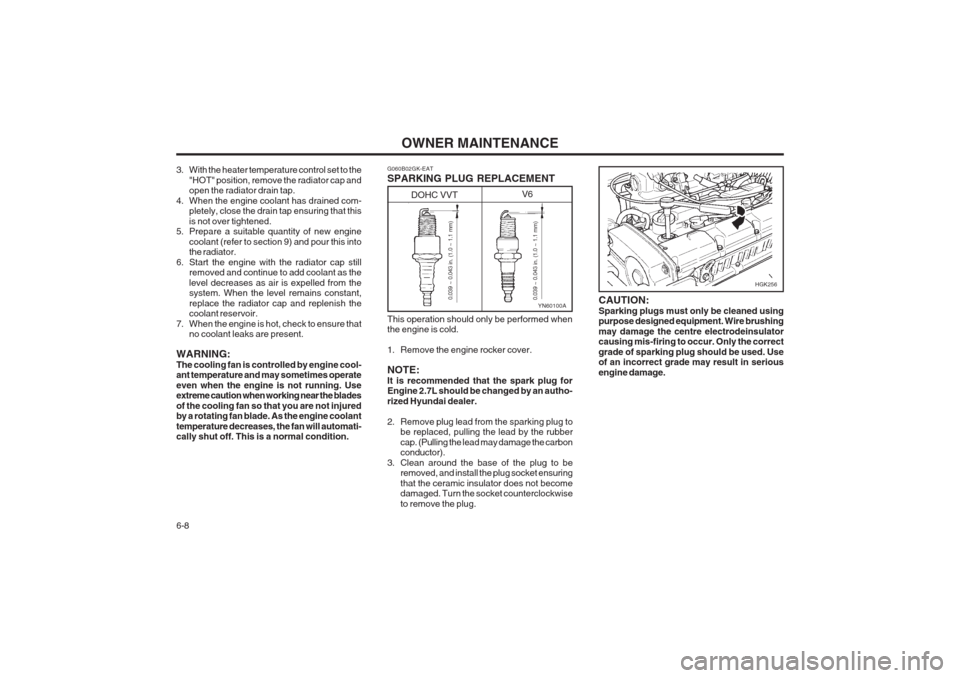
OWNER MAINTENANCE
6-8 CAUTION: Sparking plugs must only be cleaned using purpose designed equipment. Wire brushing may damage the centre electrodeinsulator causing mis-firing to occur. Only the correct grade of sparking plug should be used. Use of an incorrect grade may result in serious engine damage.
3. With the heater temperature control set to the
"HOT" position, remove the radiator cap and open the radiator drain tap.
4. When the engine coolant has drained com- pletely, close the drain tap ensuring that this is not over tightened.
5. Prepare a suitable quantity of new engine
coolant (refer to section 9) and pour this into the radiator.
6. Start the engine with the radiator cap still removed and continue to add coolant as the level decreases as air is expelled from the system. When the level remains constant, replace the radiator cap and replenish the coolant reservoir.
7. When the engine is hot, check to ensure that no coolant leaks are present.
WARNING: The cooling fan is controlled by engine cool- ant temperature and may sometimes operate even when the engine is not running. Use extreme caution when working near the blades of the cooling fan so that you are not injured by a rotating fan blade. As the engine coolant temperature decreases, the fan will automati- cally shut off. This is a normal condition. G060B02GK-EAT SPARKING PLUG REPLACEMENT This operation should only be performed when the engine is cold.
1. Remove the engine rocker cover.NOTE: It is recommended that the spark plug for Engine 2.7L should be changed by an autho- rized Hyundai dealer.
2. Remove plug lead from the sparking plug to
be replaced, pulling the lead by the rubber cap. (Pulling the lead may damage the carbon conductor).
3. Clean around the base of the plug to be removed, and install the plug socket ensuring that the ceramic insulator does not become damaged. Turn the socket counterclockwise to remove the plug.
YN60100A0.039 ~ 0.043 in. (1.0 ~ 1.1 mm)
0.039 ~ 0.043 in. (1.0 ~ 1.1 mm)
DOHC VVT V6
HGK256
Page 114 of 140
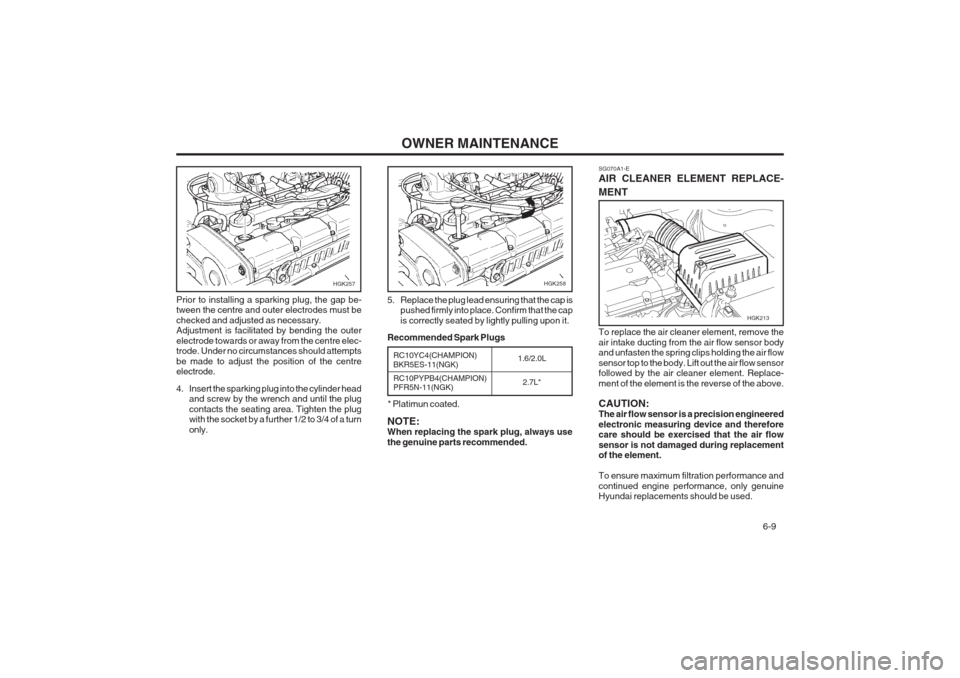
OWNER MAINTENANCE 6-9
SG070A1-E AIR CLEANER ELEMENT REPLACE- MENT
Prior to installing a sparking plug, the gap be- tween the centre and outer electrodes must be checked and adjusted as necessary. Adjustment is facilitated by bending the outer electrode towards or away from the centre elec- trode. Under no circumstances should attempts be made to adjust the position of the centre electrode.
4. Insert the sparking plug into the cylinder head and screw by the wrench and until the plug contacts the seating area. Tighten the plug with the socket by a further 1/2 to 3/4 of a turn only. 5. Replace the plug lead ensuring that the cap is
pushed firmly into place. Confirm that the capis correctly seated by lightly pulling upon it.
Recommended Spark Plugs To replace the air cleaner element, remove theair intake ducting from the air flow sensor body and unfasten the spring clips holding the air flow sensor top to the body. Lift out the air flow sensor followed by the air cleaner element. Replace- ment of the element is the reverse of the above. CAUTION: The air flow sensor is a precision engineered electronic measuring device and therefore care should be exercised that the air flow sensor is not damaged during replacement of the element. To ensure maximum filtration performance and continued engine performance, only genuine Hyundai replacements should be used.
NOTE:When replacing the spark plug, always use the genuine parts recommended.
RC10YC4(CHAMPION) BKR5ES-11(NGK) RC10PYPB4(CHAMPION) PFR5N-11(NGK)1.6/2.0L
2.7L*
* Platimun coated.
HGK213
HGK258HGK257